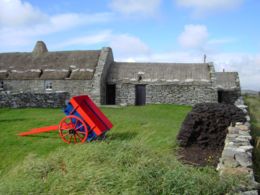Aeroplane Homes
Floating Homes
Bubble House
Bunkers
Living in a Bus
Container Homes
Cosmic Garden
Crofts
The Crooked House
Dome House
Dome House at Sea
Dymaxion House
Eco-Homes
The Egg House
Grass Roofs
Gunnite House
Hovercraft House
Martello Towers
Modern Architecture
Mushroom House
Pickle Barrel House
Pyramid House
Living in Railway Carriages
Sculptured House
The Shoe House
Sliding House
Spanish Cave Houses
House of Straw
Toilet House
Tree Houses
Tsui House
UFO
Underground Cities
Underground Homes
The Upside-Down House
Crofts In Finland
Crofts were rented farms usually situated far from village centres, in the hinterlands of the main farms. Farms usually had a single cottage in the grounds, which could be extended by the tenants, and storage buildings could be added to the rented grounds as well. In addition to the rent, the crofters had to take care of the buildings on their grounds and possibly of the road leading there.The crofters paid the rent to the landlord as prearranged days of work and possibly also as produce such as wool yarn or lingonberries. Contracts were signed on the rights and duties of the crofters. The contract was often effective until the death of the crofter, but there were also evictions, especially in the beginning of the 20th century.
Kuva: S. Silen A large part of the crofts of Central Finland were in the Jamsa area: crofts were not as popular elsewhere in the province. The first crofts were founded in Jamsa as early as the 1720s. The number of crofts in the area increased rapidly from the middle of the 19th century, and by the year 1860 Jamsa already had 385 crofts. Few crofters lived in village centres; their farms were situated in the hinterlands of the large main farms. Crofts sometimes formed scattered village communities in previously uninhabited areas, which formed the basis for present villages.

Crofts In Scotland:
A croft is an area of land designated for agricultural use and there may or may not be a dwellinghouse on the croft. Crofts fall into 2 distinct categories namely tenanted crofts and owner occupied crofts.Owner-occupied croft:- The purchase of an owner-occupied croft is more straightforward than the assignation of a tenanted croft and in effect you are purchasing a large area of land with or without a dwellinghouse thereon which is however subject to crofting tenure. Your purchase of the croft does not require the approval of the Crofters Commission as is the case when acquiring the tenancy of a tenanted croft. Nevertheless the croft will almost certainly be subject to crofting tenure and if you are not utilising the croft for agricultural purposes you may very well be required by the Crofters Commission to grant a tenancy to someone who will work the croft.
Tenanted croft:- In the case of a tenanted croft what is being acquired is a large area of land with or without a house thereon which is held on a crofting lease. The outgoing crofter is assigning to you his lease of the croft. A crofting lease is completely different to a commercial or urban lease and you should consult a solicitor on its terms and implications. Subject to certain criteria it constitutes a secure form of tenancy and you can pass on succession to a member of your family. The important aspect to note is that when seeking to acquire the assignation of a tenanted croft the assignation must be approved by the Crofters Commission who will require some detail of your background to assess your suitability as a crofting tenant and your proposals for the future use of the croft.
The word croft is West Germanic in etymology, and is now most familiar in Scotland, where many Highlands and Islands crofters have had their tenure protected by special legislation since 1886. Elsewhere the expression is generally archaic. Essentially similar positions have been the medieval villein and the Scandinavian torpare.
The Parliament of the United Kingdom created the Crofters' Act, 1886, after the Highland Land League had gained seats in that parliament. The government was then Liberal, with William Gladstone as Prime Minister. Another Crofters' Act was created in 1993 (the Crofters' (Scotland) Act, 1993). The earlier Act established the first Crofting Commission, but its responsibilities were quite different from those of the newer Crofting Commission created in 1955. The Commission is based in Inverness.
Crofts held subject to the provisions of the Crofters' Acts are in the administrative counties of Shetland, Orkney, Caithness, Sutherland, Ross-shire, Inverness-shire and Argyll, in the north of Scotland.
Under the 1886 legislation (the Crofters' Holdings (Scotland) Act) protected crofters are also members of a crofters' township, consisting of tenants of neighbouring crofts with a shared right to use common pasture.
Since 1976 it has been legally possible for a crofter to acquire title to his croft, thus becoming an owner-occupier.
Cyber-crofting is a term coined and used since 2001 by residents of the Scottish Highland village of Clashnessie. It refers to the incorporation of web-based income-generation into the classic range of crofting activities which can include, but is not limited to: fishing, agriculture, keeping cattle or sheep, jobbing building, bus-driving, caretaking and cleaning. This combination of different activities is characteristic of many permanent residents of the Highlands and is not limited to those working land that has been officially designated as a croft.